Introduction
Lifeboats are an essential component of all vessels at sea. They are the backup when all else fails and the crew must abandon the ship for survival. In this article, we explore the different types of lifeboats and their advantages. Let us begin.
What is a lifeboat?
A lifeboat is a self-sufficient specialised watercraft that provides a means of escape from ships, offshore platforms and other vessels in emergency situations. It is designed to withstand harsh conditions and has many inherent features that support a safe evacuation process.
The design, construction, and maintenance of lifeboats follow international regulations set by organisations such as the International Maritime Organization (IMO) through conventions such as SOLAS. Through these regulations, we can ensure that the lifeboats are built up to a certain quality and perform functions as designed during emergencies.
During emergencies, they may be boarded while stowed at the embarkation deck or through the embarkation ladder as is convenient.
Types of Lifeboats
There are many diverse types of lifeboats depending on the construction, capacity, launching method, and propulsion specifications. Generally, the lifeboats can be divided into eight major types. These are:
-
Open lifeboats
-
Partially enclosed lifeboats
-
Fully enclosed lifeboats
-
Free fall lifeboats
-
Rescue boats
-
Inflatable lifeboats
-
Hyperbaric lifeboats
-
Fireproof lifeboat
Let us briefly discuss each of these types.
Open Lifeboats

Open lifeboats are open to the weather. These were the first type of lifeboats when they were introduced in the 18th century. These lifeboats may be oar-powered or engine powered.
These lifeboats are the least safe due to there being no protection from the weather and water ingress. They are also not self-righting, i.e., once toppled, they do not become upright by themself. Hence, these lifeboats are no longer used in the majority of applications.
Partially enclosed lifeboat
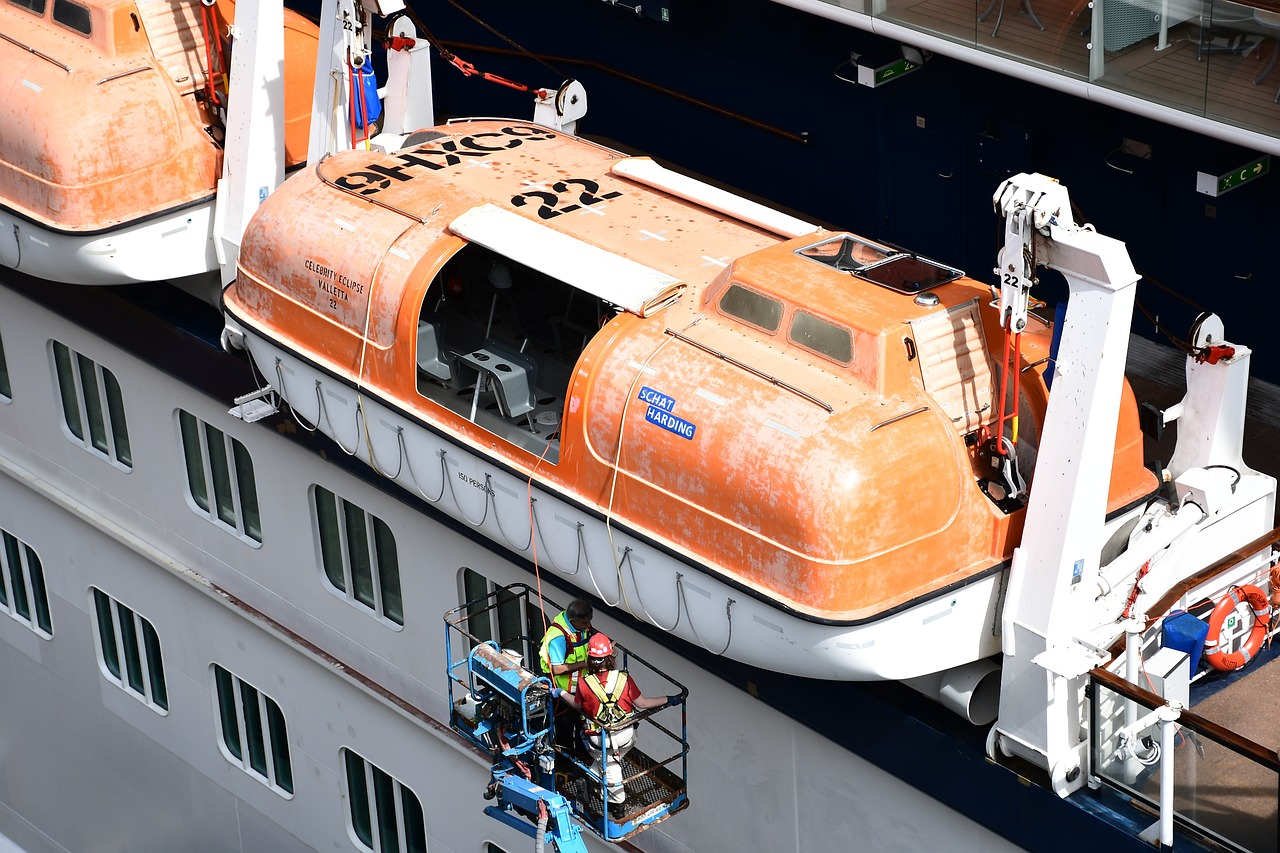
A partially enclosed lifeboat with canopies open
The partially enclosed lifeboat consists of openings on the side of the lifeboat. These openings expedite the boarding of lifeboats in an emergency situation.
The lifeboats are typically motorised with the help of a compression ignition engine. The openings can be covered with canopies once everyone has boarded but these canopies are not completely watertight.
Totally Enclosed Lifeboat or Closed Lifeboat
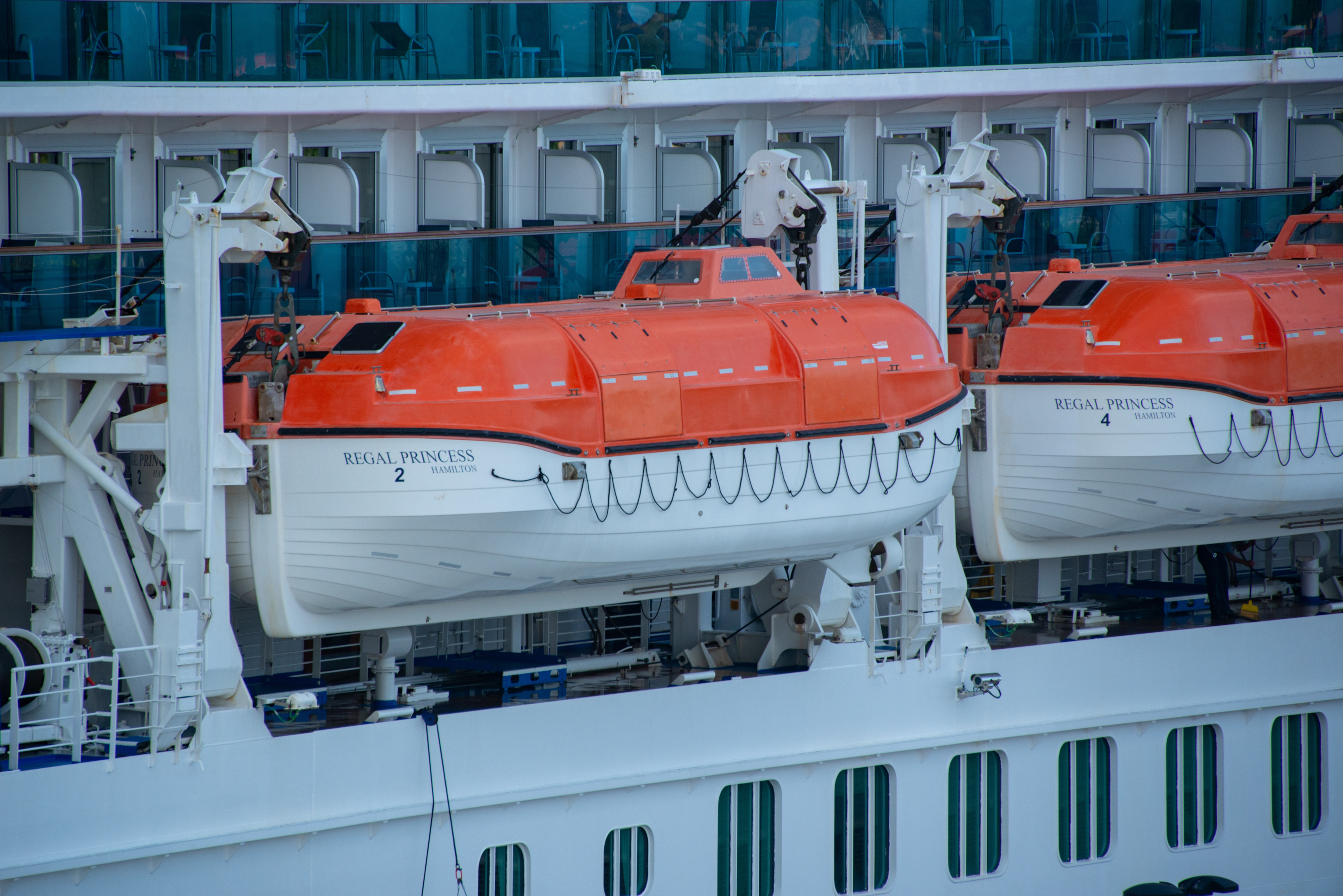
Totally enclosed lifeboats on a passenger ship
Totally enclosed lifeboats provide complete protection from weather and water ingress. Once boarded and secured, closed lifeboats prevent water entry and provide a much safer way to evacuate a sinking vessel.
Most enclosed lifeboats are also inherently self uprighting. This eliminates the risk of capsizing as the vessel becomes upright should it topple over during launch or due to waves.
Free fall lifeboat
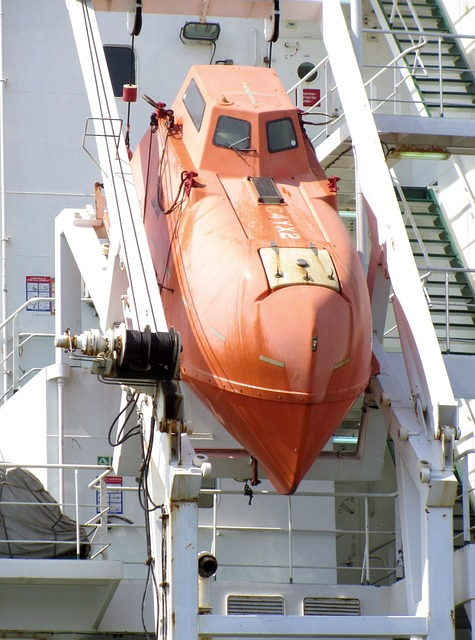
Freefall lifeboat
The free fall lifeboat is a special type of lifeboat that is dropped from a height directly into the water. The aerodynamic shape ensures the safety of the occupants as the vessel contacts the water and floats back up.
Generally, the location for a free fall lifeboat is the stern of the vessel. A single lifeboat is stowed on a downward-sloping slipway that enables the free fall of the lifeboat under gravity once the hooks are released.
Rescue boats
Rescue boats are a special type of lifeboat meant to rescue people that have become stranded at sea. This could mean people that have fallen off your ship (Man overboard) or survivors from the sinking of another vessel.

Rescue boat operated at sea
Rescue boats may be further classified as those with inboard engines and those with outboard engines.
Merchant vessels can have one rescue boat in addition to the two lifeboats. One of the lifeboats present onboard could also be designated as a rescue boat if it complies with the rescue boat regulations set by SOLAS. In most cases, the starboard side lifeboat is designated as the rescue boat as vessels berth more frequently on the port side.
Inflatable lifeboat
Small vessels such as yachts may not have the space required to accommodate a rigid lifeboat. Such vessels may then be equipped with inflatable lifeboats. On the other hand, large merchant vessels are provided with inflatable liferafts instead of lifeboats.
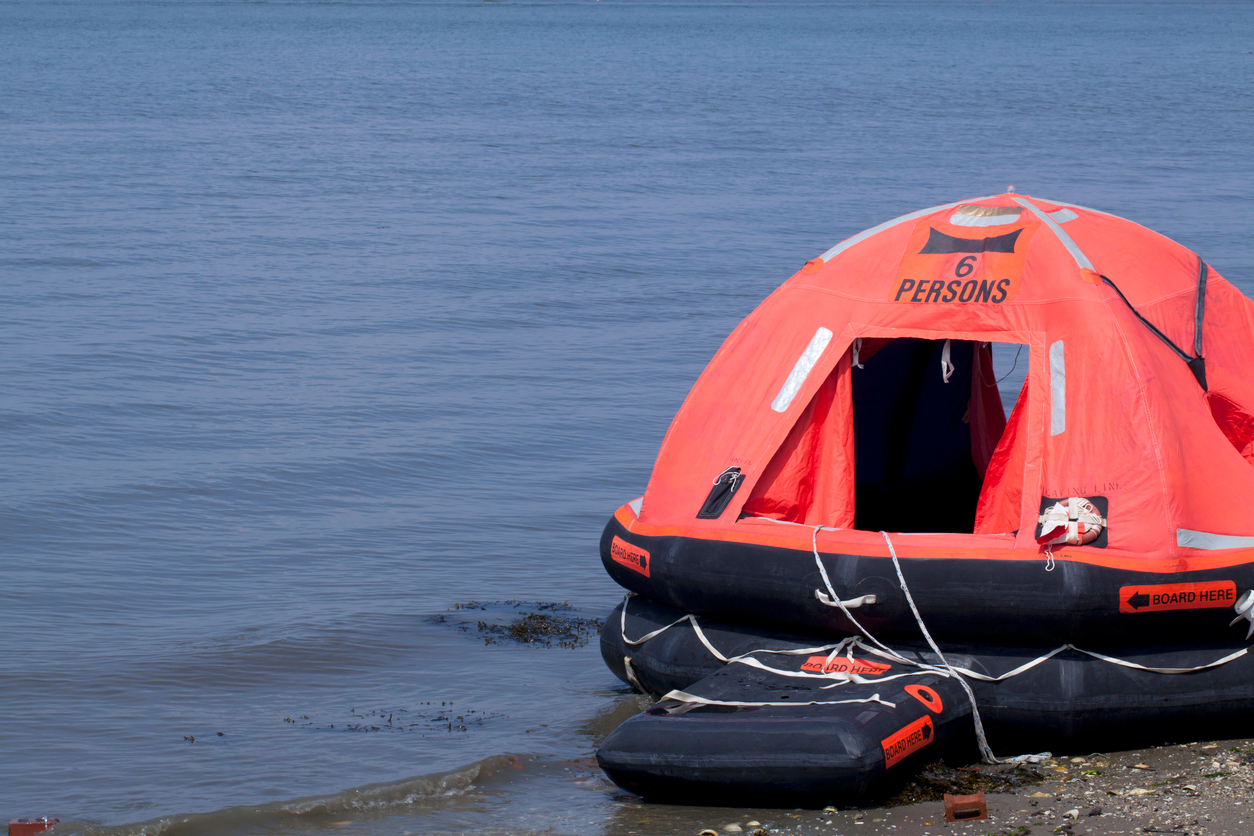
Inflatable liferaft
Almost all inflatable lifeboats can auto-inflate using a cartridge that provides air at high pressure to inflate the liferaft to the recommended pressure.
A mechanical pump may also be provided to top up the air and increase the internal air pressure in cold environments where the air density becomes low due to low temperatures.
Also, liferafts on merchant vessels can inflate without human intervention in emergencies when the vessel sinks and the water level above the life raft’s HRU (Hydrostatic Release Unit) is more than 4m.
Hyperbaric lifeboats
Hyperbaric lifeboats are a special type of lifeboats used on diving vessels. These lifeboats are used to evacuate divers from a main diving vessel in the case of a major emergency.
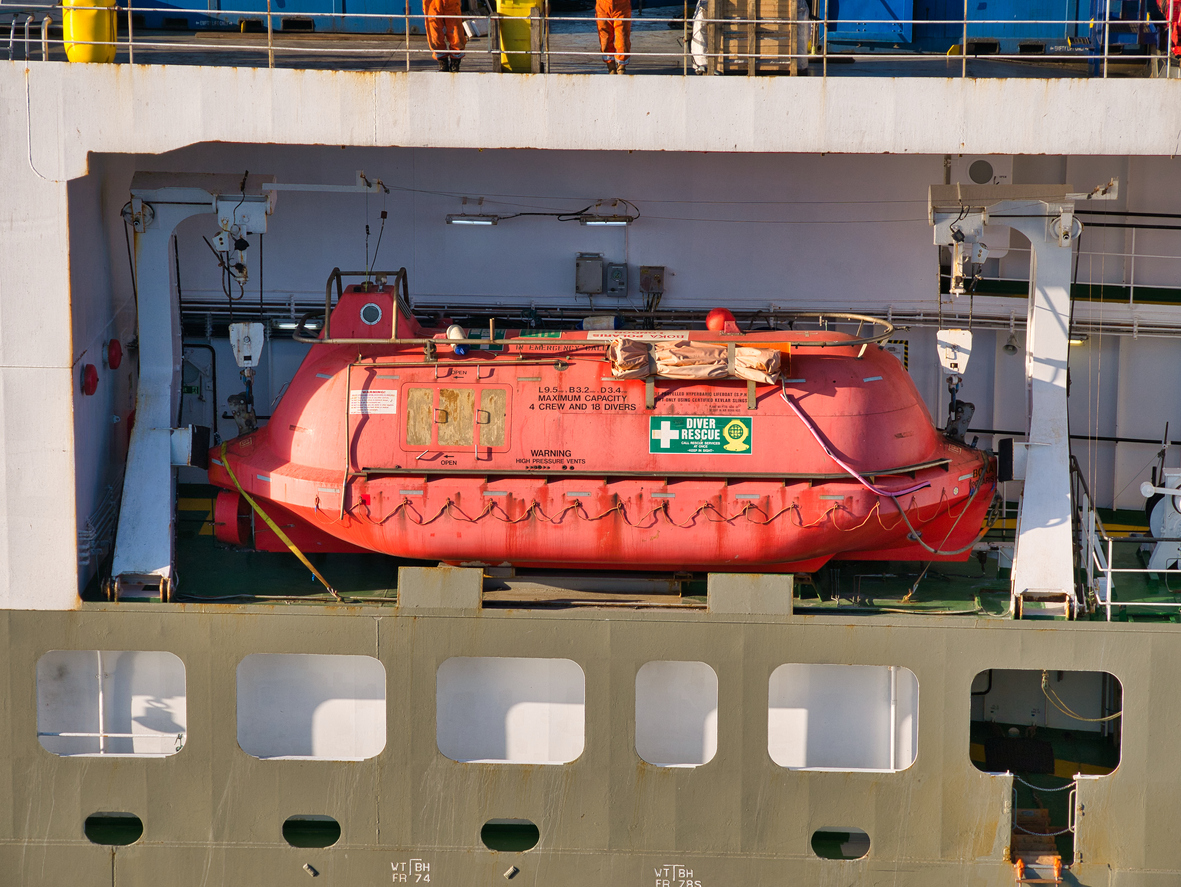
A hyperbaric lifeboat on a North Sea support vessel in Aberdeen harbour.
They have a hyperbaric chamber which allows divers to evacuate without undergoing decompression.
These lifeboats are equipped with much more equipment than traditional lifeboats. They have ancillary equipment such as generators, engines, life support systems, and other crew facilities that ensure a minimum independent survival of 72 hours.
Fireproof lifeboats
Fire-protected or fireproof lifeboats have additional features over a standard lifeboat to endure passage through fire for a limited time period (8 minutes).
These lifeboats are used in vessels such as oil and chemical tankers where there is a heightened risk of fire. The vessels are equipped with a water sprinkler system that pulls in water from the lowest point on the boat and sprays it on the outside to protect them from intense fires.
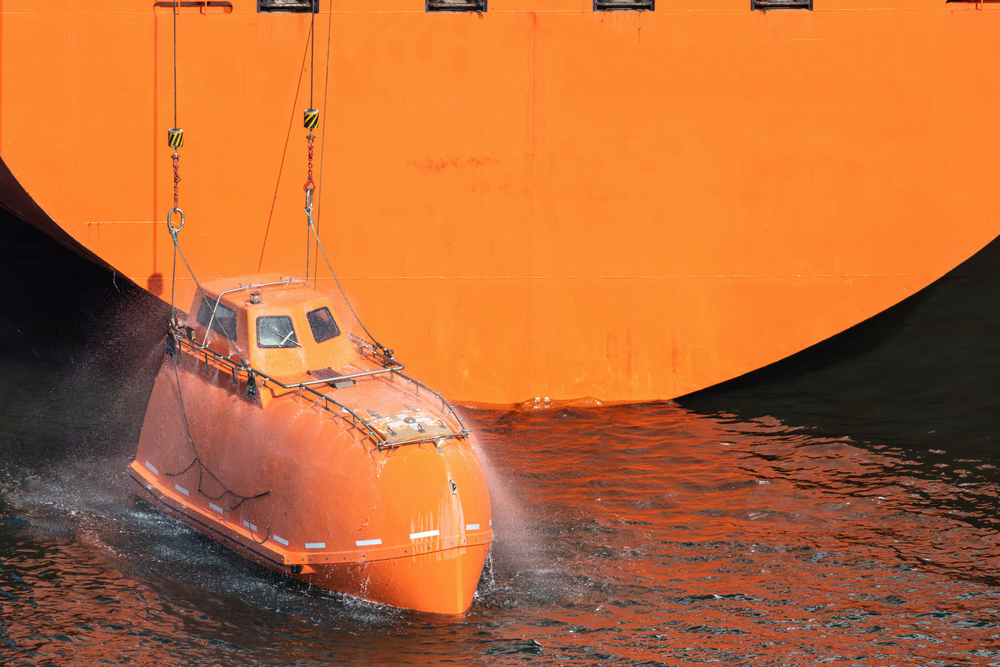
Fire-protected lifeboat with the water sprinkling system in operation
They are also provided with an independent air supply system for occupants for a limited duration. With these features, the lifeboat can effectively navigate through fires until it gets a safe distance away from the incident site.
Capacity for Lifeboats on Cargo Ships
Every cargo ship must carry at least two lifeboats if they are davit operated with one on each side of the ship. Each lifeboat should be able to accommodate the entire complement. This is to ensure that everyone can fit into one boat in the event that only one boat can be launched.
In addition to this, the vessel’s liferaft capacity should be 100% of the number of persons onboard if the liferafts can be shifted to either side on the ship’s deck. If they cannot be shifted, the liferafts must also have 100% capacity on either side (Total capacity of 200%).
Lifeboat safety equipment
A lifeboat generally consists of the following equipment:
Survival equipment
-
Survival manual
-
Rations and freshwater
-
Graduated drinking vessel
-
First aid kit
-
Anti-seasickness medicine and seasickness bag
-
Portable search light
-
Thermal protective aids (10% of lifeboat capacity or 2 whichever is greater)
-
Dipper/Ladle
-
Hatchets and jack-knife
-
Fishing tackles
-
Three tin openers
-
Dipper with lanyard
-
Two boat-hooks
-
Two painters
-
Engine tools
-
Fire extinguishers
-
One bailer and two buckets (Buoyant)
-
Two rescue quoits with a 30m buoyant line
-
A manual pump if the lifeboat is not self-bailing
-
Life-saving signals poster
Navigation equipment
-
Buoyant oars (Not applicable for free-fall lifeboats)
-
Compass
-
Drogue or sea-anchor
Distress signalling equipment
-
Radar reflector
-
Signaling mirror
-
Pyrotechnics (Four rocket parachute flares, two hand flares, two buoyant smoke signals)
-
Waterproof torches (With spare bulbs and batteries)
-
Whistle
Conclusion
In conclusion, lifeboats are one of the most essential pieces of equipment on ships. They are not just vessels but provide safety and reassurance in the face of adversity. Understanding the different types and their features is important for maritime safety. We hope that this article serves as a sufficient introduction to the different types of lifeboats at sea.

